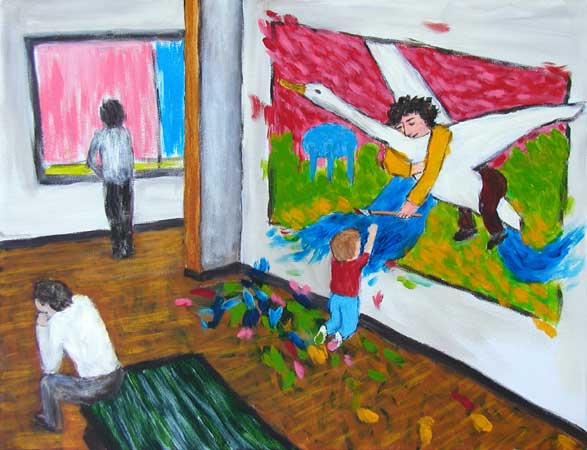
“Epiphany in Prague” contemporary figurative painting. acrylic on canvas. 14 in x 11 in.
“Epiphany in Prague” contemporary figurative painting
I’m certain Chagall loves me. He definitely gave me a paint brush in Prague.
It happened on the last day of our honeymoon, the day my wife and I had set aside for the national art museum. We were still heavily jet-lagged and a little hung-over, and we struggled out of bed at noon only to learn that the museum was closed that day. We didn’t have any time to lose, so I did the best I could with the guide-book and blood-shot eyes and had us on a trolley to another museum within minutes. I wasn’t able to read through all the details, and it was out a ways, but it was the only museum open that day, and it looked big on the map.
As we rolled out of the cobbled streets of old Prague and into the 1970’s apartment buildings of the outer quarters, I began to get a glimpse of real life in post-communist Prague. Suddenly graffiti and broken windows began to appear. There were dumpsters, trash and Kentucky Fried Chickens. A guy with a mullet was beating his cell phone on the side of a car that wouldn’t start. I began to wonder what the museum would be like.
The museum turned out to be colossal, probably the largest piece of 1970’s modernist architecture I had ever seen. It went on for days and days, room after room. There was just one problem. The communists had built a huge structure but hadn’t retained enough collection to fill all the galleries. Consequently, there was an emphasis on lesser-known works and works by lesser-known artists, and many of the paintings appeared to have survived the black market merely by being too subtle or melancholy or less appealing.
Still, I had seen a few paintings and carvings that had made me catch my breath, so I didn’t spend time studying something if it didn’t catch my eye and draw me in. There was always another painting, always another gallery, and maybe not enough time. I dragged Darlene as quickly as I could.
Then, in one gallery, I hurried past some doodles on what appeared to be a piece of typing paper. At a glance, it was like a little kid’s drawing in graphite pencil. The lines were faint, barely visible, and the figures were all constructed from rectangles and triangles. On top of this diagram, blue and red watercolor had been streaked like test swatches. It was a plan or an outline or a series of “notes” for some larger piece of art, but it had as much magic as any piece of art I had seen in the museum that day.
Then it stuck me. This was a Chagall, the first I had seen in the museum! But it couldn’t be. It looked just like stuff I would draw when I was building or making something. But I couldn’t draw. I mean I drew all the time, but not seriously. What did this mean?
Had I ever tried to draw? I mean seriously tried, with the same sort of effort I had applied to learning calculus in engineering school. That had been tough. I had spent all my time in high school reading literature and natural history, but then I suddenly found myself in the college of engineering, deprived of any time to read or think or do anything. On top of that, I suddenly had to learn things like calculus, optics and thermodynamics as best I could or risk loosing my scholarship and getting sent back to the Delta.
It had been a real challenge, especially the foundations of the calculus, but I mastered it. I even went on to tutor it for beer money. I remember how disgusted I would get with my students. They got frustrated so easily. Didn’t they know it was a little arrogant to expect to understand something important the first time they skimmed through it? Hadn’t they ever had to struggle with anything before?
What did this mean? Did this mean that I could learn to draw and paint seriously? I told my wife that something important had just happened. On the flight back, I doodled on envelopes and barf bags and whatever paper I could find. When I got home, I found a set of acrylic paints I had tried to use briefly a half decade before. Surprisingly they were still good. I started painting and didn’t stop.

